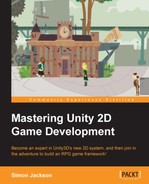Arguably, the inventory system in any good RPG game is one of the most important components. Depending on the style or background of your design, it may be even more important than the story or battle system. The reason I say this is because the way in which you'd design and implement your shopping and inventory system will alter how your game is played and how quickly the player will progress through your creation.
Another factor that we will cover in this chapter is monetization. Every title needs to have a monetization story so that the player will eventually be able to make money through his or her hard work. There always has to be some kickback in the end to help you pay the bills or keep tabs on your sanity. It doesn't have to be money; it could just be recognition or an aid to your portfolio. However, in most cases, it's about money.
The list of topics that will be covered in this chapter is as follows:
- Looking at the inventory and items
- Building a shop and an inventory UI layer
- Looking at monetization options
- Handling back navigation
People have been asking this question since caveman times probably (although granted that Walmart wasn't yet open). What things do you need to help you become contented in the world; let me pose that eternal question as an example, "Do these shoes make me look fat?". Such questions have no real answer other than our appetite as humans to collect things, and if they help us feel good about our lives, all the better.
The same is true in the gaming world. Adventures need things to help the budding adventurer along, to make them better, and look better in a lot of modern games.
The motivation to buy things is strong, and we have come to expect this in almost any game. From a simple adventure game where we just pick things up off the street that may come in useful later, fashion games where you have to be as pretty as possible, to full-fledged RPG games where inventory is everything, this motivation is indispensable. If you haven't got that level 20 sword of ultimate banishing, you just aren't going to make it in the world. Even FPS games aren't immune to this phenomenon. If you can't upgrade and tweak your weapons, you are seen as old and out of touch.
One of the biggest rises in consumerization these days has happened in the casual market; just about every casual game has coins that you can collect to unlock power-ups, extra levels, or even skins for your character to change their appearance (they serve no actual value but just add further depth to the game). It is astounding how simple tap-and-flick games have become some of the biggest marketing machines.
It is important to keep all of this in mind and look at the real world when designing any shopping/inventory system for your RPG game. The more it feels like something that someone would do in real life, the more at home they will feel with it, and the easier they will find using it.
You should always be asking the following questions to yourself while designing such a system:
- How does an item add value?
- Does it seem affordable?
- Is it going to improve the play? (Doesn't actually have to?)
- Is it desirable?
- Is it better to know what the player will already have and why?
- Is it for single use (consumable) or fixed (durable/nonconsumable)?
- Will it break or wear out over time?
A lot of this leads us beyond just what is good for the game; it leads us to what is good for the player. Another factor that can lend weight to this is whether we are going to monetize certain powerful items. However, we will cover more on this later.
